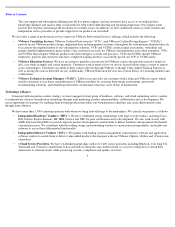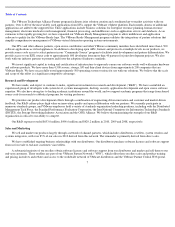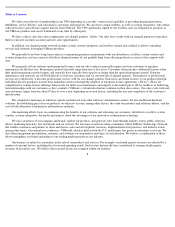VMware 2010 Annual Report Download - page 19
Download and view the complete annual report
Please find page 19 of the 2010 VMware annual report below. You can navigate through the pages in the report by either clicking on the pages listed below, or by using the keyword search tool below to find specific information within the annual report.
Table of Contents
2009 acquisition of SpringSource, we announced our intention to use SpringSource solutions to extend VMware’
s strategy to deliver solutions in
the emerging PaaS market and have since, also acquired GemFire and RabbitMQ as part of VMware’s overall PaaS strategy. Additionally,
SpringSource’s current offerings and their underlying open source technology position us in the enterprise and web application development and
management markets. Our February 2010 acquisition of Zimbra extended our footprint to cloud-based email and collaboration services—a part
of VMware’s strategy to extend into the emerging SaaS market. We also recently announced our vCenter family of products to more fully
manage virtualized and cloud environments, which may cause us to compete with other virtualization management vendors.
These initiatives may present new and difficult technology challenges, end-users may choose not to adopt our new product or service
offerings, and we may be subject to claims if customers of these offerings experience service disruptions or failures, security breaches or other
quality issues. Further, the success of these new offerings depends upon the cooperation of hardware, software and cloud hosting vendors to
ensure interoperability with our products and offer compatible products and services to end-users.
The cloud computing and end-user computing markets are in early stages of development. Other companies seeking to enter and develop
competing standards for the cloud computing market, such as Microsoft, IBM, Oracle, Google and Amazon, and the end-
user computing market,
such as Citrix and Microsoft, have introduced or are likely to introduce their own initiatives that may compete with or not be compatible with our
cloud and end-user computing initiatives which could limit the degree to which other vendors develop products and services around our
offerings and end-users adopt our platforms. Additionally, our operating margins in our newer initiatives may be lower than those we have
achieved in the markets we currently serve, we will need to develop appropriate pricing strategies for our new product initiatives and we may not
be successful enough in these newer activities to recoup our investments in them. If any of this were to occur, it could damage our reputation,
limit our growth and negatively affect our operating results.
We rely on distributors, resellers, system vendors and systems integrators to sell our products, and our failure to effectively develop, manage
or prevent disruptions to our distribution channels and the processes and procedures that support them could cause a reduction in the
number of end-users of our products.
Our future success is highly dependent upon maintaining and increasing the number of our relationships with distributors, resellers, system
vendors and systems integrators. Because we rely on distributors, resellers, system vendors and systems integrators, we may have little or no
contact with the ultimate users of our products, thereby making it more difficult for us to establish brand awareness, ensure proper delivery and
installation of our products, service ongoing customer requirements, estimate end-user demand and respond to evolving customer needs.
Recruiting and retaining qualified channel partners and training them in the use of our technology and product offerings requires
significant time and resources. In order to develop and expand our distribution channel, we must continue to expand and improve our processes
and procedures that support our channel, including our investment in systems and training, and those processes and procedures may become
increasingly complex and difficult to manage. The time and expense required for sales and marketing organizations of our channel partners to
become familiar with our product offerings, including our new product developments, may make it more difficult to introduce those products to
end-users and delay end-user adoption of our product offerings.
We generally do not have long-term contracts or minimum purchase commitments with our distributors, resellers, system vendors and
systems integrators, and our contracts with these channel partners do not prohibit them from offering products or services that compete with
ours. Our competitors may be effective in providing incentives to existing and potential channel partners to favor products of our competitors or
to prevent or reduce sales of our products. Certain system vendors now offer competing virtualization products preinstalled on their server
products. Additionally, our competitors could attempt to require key distributors to enter into exclusivity
16
























